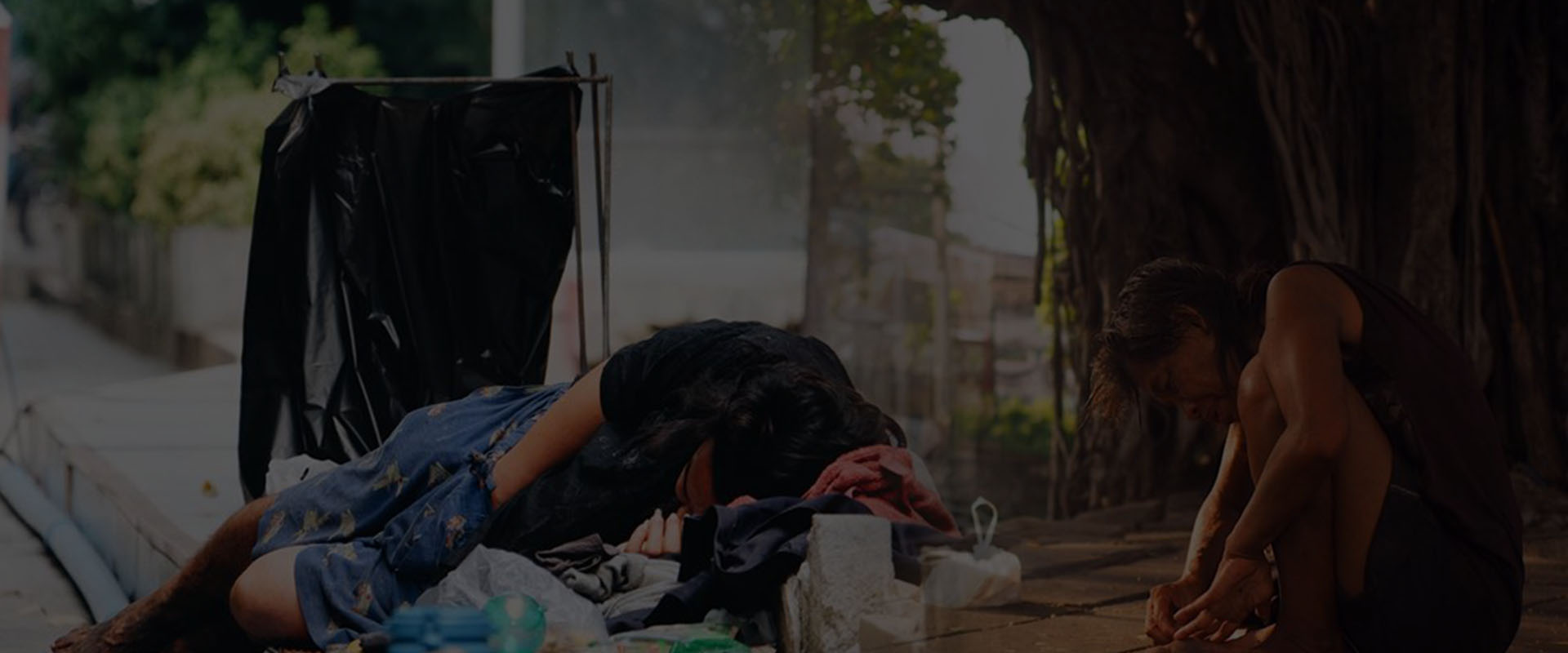Story: Kittin Likitparinya
The Thai public health system is making great strides in the sphere of peaceful death, whether in the growing public awareness of palliative care or the news of a Thai citizen who chose to have a mercy killing in Switzerland in March 2019 that recently went viral — another controversy which brought certain sensitive topics related to death into the national discourse.
Yet despite a greater awareness of the “right to die” and dignity in death the discourse seems to be limited to the world of the majority of society. For in the perspective of those who live on society’s peripheries, such as the sick and homeless living on Bangkok’s roads, the notion of a ‘peaceful death’, may as well be nothing more than a phrase heard in a dream.

Sickness among the Homeless
The diseases that afflict the homeless — who have but the sky as their ceiling and the stars as their light — can be primarily divided into physical and mental illnesses.
Physical Illnesses
According to Sithipol Chuprajong, team leader of the Foundation for Patients on the Streets (a tributary of the Mirror Foundation), homeless people commonly get sick from contracting HIV, tuberculosis, liver disease, or an infected wound, since they do not have access to proper dressing. Furthermore, the majority of homeless people are not familiar with the process of seeking treatment at hospitals, and have no access to public healthcare benefits.
For example, a homeless person with HIV or tuberculosis may not know how to get themselves treatment, and also have to deal with many other obstacles. “They may carry the 30-baht universal healthcare ID, but if they migrated from the provinces and are now living in Bangkok, they won’t be able to use it at hospitals in Bangkok. Or, as we’ve been seeing more recently, homeless people with liver disease, blisters, infected and rotting wounds that were not able to get treatment — or did get treatment and didn’t recover since they received inadequate care — seem to have given up on taking care of themselves.”
Mental Illnesses
Mental illnesses and disorders are another form of ‘sickness’ that homeless people struggle with too. Mr. Sithipol adds that “a large number of mentally ill people are homeless and live in public spaces… many of them are schizophrenic, which has direct consequences for their quality of life, since they suffer from hallucinations, ringing ears, and become disconnected from reality.”

What is the difference between unhoused people and mentally-ill people on the streets?
Though unhoused people and mentally-ill people on the streets may live in the same public spaces, mentally-ill people primarily end up on the streets because of their psychological symptoms, whereas unhoused people in general tend to be driven on to the streets due to family conflict.
“Mentally-ill people on the streets and the general homeless population are two different groups of people that don’t have much overlap. Homeless people tend to have left their homes because of conflict with their family. Around 90% of them had problems at home.”
“However, mentally-ill people on the streets usually end up there because of symptoms of confusion or memory loss when they have no one looking after them.”

Funerals for Mentally-Ill People Who Were Living on the Streets
The meaning of a ‘good death’ is usually intertwined with the notion of a peaceful death: living the last days of one’s life at home or in a place where one is surrounded by loved ones. However, death for the mentally-ill people on the streets and the general homeless population, is a final breath taken on the sidewalk, or sometimes dying in the middle of the street.
“Most of the time they pass away on the sidewalk… Yes, they take their last breath there. Sometimes it’s from an accident, but not often, unless they are drunk or in an especially dangerous area. There is one case I know of, someone who lived on the road to Kok Salak, where there is a traffic island in the middle of the road. A car came out of nowhere and hit him, and he died,” recalls Mr. Sithipol.
What Happens When A Homeless Person Dies on the Streets?
When moving the body of a homeless person who has passed away, the team from the Foundation for Patients on the Streets follows this procedure:
The team transports the body to a hospital. 2. The team will try to contact the relatives of the deceased to claim the body and make funeral arrangements according to their religion. If they are unable to contact any relatives then the body is brought to the temple and cremated.
“To bring the body of the deceased out of the hospital, the hospital must see proof of family relationship from a relative present before they can allow the body to be taken to perform the religious rituals. But when there aren’t any relatives present, a member of the Poh Teck Tung Foundation comes to visit, and the deceased isn’t given a funeral.”
Are there relatives who refuse to claim the body?
“I’ve yet to come across that. Most of the time, we are able to contact the relatives but there have also been many occasions when we weren’t able to reach anyone and we had to bury the body ourselves.

Constraints of the Foundation for Patients on the Streets
At present, the Foundation for Patients on the Streets coordinates support for unhoused people with physical and mental illnesses. Once the team identifies a sick homeless person, their next step is to contact the police, who transport the individual to the hospital.
However, one of the problems with this procedure is that the police do not have any measures in place for transporting homeless people to the hospital, and sometimes hospitals refuse them treatment.
“Certain steps in our procedure aren’t reliable enough, or do not account for the needs of a sick individual. For example, the homeless person may be handcuffed and made to sit at the back of the police truck on the way to the hospital. Some hospitals even refuse to help them.”
In addition to the obstacles to sending a patient to the hospital, the lack of knowledge and understanding of mental illness among the general public is also a barrier to supporting homeless people as well. As an example, certain groups of people have the misguided notion that mentally-ill people are no different from other people because they are able to do certain basic tasks, such as buying things.
“When people don’t see a mentally-ill person as someone who is sick, they also don’t feel the need to help them, and leave them to fend for themselves on the streets. This is an issue of mindset. As for the matter of providing other forms of support, such as taking them to the hospital–
“There is a system in place where when you come across someone ill and you can immediately notify the authorities. To give you an idea, if we were to see someone have a medical emergency, we’d know to immediately call 1669, and then leave it to the system. But there is no system like that in place for homeless people or mentally-ill people who are living in public spaces.”
The Origin of the Foundation for Patients on the Streets
Before the foundation was created, it’s team used to work for the Mirror Foundation’s Centre for Missing People. After working at the centre for a while, they had gathered enough information to begin to see certain patterns and realized that a portion of the missing people were mentally-ill as well.”
“… there was this one database,” recalls Mr. Sithipol, “that showed us that there was a certain number of people missing from their homes who were also mentally-ill. They were homeless and wandering the streets. So, I had the idea to start this foundation and create a system for helping them, as well as solve other problems that we can handle in a way that stays within the law.”
“So, at first we focused on mentally-ill homeless people, but as we kept going we ended up covering them all– both physically and mentally-ill patients.”
An important incident that led to the founding of the Foundation for Patients on the Streets is a rather poignant one: an incident, Mr. Sithipol says, where a sick homeless mother had to give birth by herself on the streets.
“Yes… she delivered the baby herself. It’s one of those stories that just lodges in your heart. No one should have to be in those circumstances. Everyone should be able to give birth at a hospital. Both the mother and baby should be well-cared for — that is, they have to be in a hospital. How can it be that a person has to give birth to their child on the sidewalk”?

After that day, the Foundation for Patients on the Streets was born.
At present, the foundation is still active. Most of its activities are documented on its facebook page @HumanOnStreet. To reach out to the foundation on behalf of a homeless person, dial 096-078-4650.
Citation: https://www.khaosod.co.th/special-stories/news_2267800
Important people mentioned: Sithipol Chuprajong, director of the Foundation for Patients on the Streets



